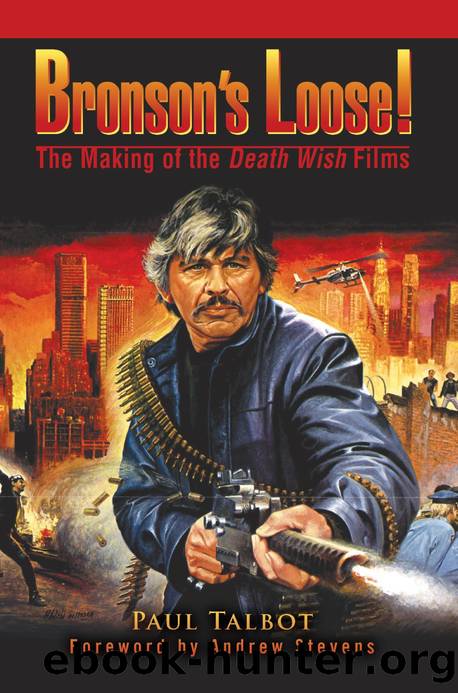Bronson's Loose!: The Making of the Death Wish Films by Paul Talbot

Author:Paul Talbot [Talbot, Paul]
Language: eng
Format: epub
Tags: Cultural, Film, Movies, Non-Fiction, Performing Arts
ISBN: 9780595823529
Google: 7s99TPwNPTMC
Amazon: 0595379826
Publisher: iUniverse
Published: 2006-02-09T00:00:00+00:00
Box for the video game from Gremlin Graphics
4
Death Wish 4: The Crackdown:
This Time It’s War!
After Death Wish 3, it was business as usual for Cannon and Bronson. In a 1985 fifty-five-page Variety ad, Menahem Golan and Yoram Globus announced no less than fifty-two upcoming movies. The company had such a high profile at that year’s Cannes Film Festival that the press called it the “Cannon Film Festival.” A year later, the Cannon ad in Variety was spread out over sixty-five glossy pages.
The Cannon-Bronson liaison continued with the 1986 action vehicle Murphy’s Law, which dealt with a hard-drinking cop who tracks down a female psychopath while handcuffed to a girl car thief. Bronson followed Murphy’s Law with the HBO cable drama Act of Vengeance (1986), in which he played a union boss, and then returned to Cannon for Assassination (1987), where he costarred with wife Jill Ireland for the last time. Golan and Globus weren’t finished with Bronson or the Paul Kersey character. At the 1986 MIFED film market, Cannon hung posters for a Death Wish 4 and promised that the film would be ready for a spring 1987 release.
Despite the heavy promotion given to highly commercial films like The Delta Force (1986) with Chuck Norris and Over The Top (1987) with Sylvester Stallone (both of which Golan himself directed), Cannon was never able to produce a box office blockbuster. The 1984 Norris epic Missing in Action, with a $38 million domestic gross, remained their biggest hit. Cannon’s “artistic” endeavors earned little acclaim and even less money. Roman Polanski’s Pirates, which Cannon acquired and released in the summer of 1986, became one of the biggest flops of all time.
By late 1986, Cannon was on shaky ground due to angry stockholders and unimpressed moviegoers. Responding to reports that his company might be going under, Golan told the press, “They’ll keep saying what they want, but we’ll go forward. We’ve never been in better shape!” The mogul announced that Cannon had three dozen movies in development for 1987, but admitted that most of the projects would be made for under $5 million.
In early 1987, as Cannon was slapped with numerous lawsuits and many of the company’s employees were cleaning out their desks, Golan and Globus began production on new entries in their most-reliable franchises: Death Wish and Missing in Action. The weak $6 million U.S. theatrical gross for Assassination proved that most Bronson’s fans were content to wait and watch the star’s new movies at home on videocassette or pay-TV, but Cannon was hoping that another Bronson Death Wish picture would sell tickets as well as videos.
To make Death Wish 4, Cannon turned to Pancho Kohner, an independent producer who was already a veteran of seven Bronson films. Kohner was the son of Paul Kohner, the successful Hollywood producer and agent and the longtime representative of Bronson. (Interestingly, the senior Kohner had urged Bronson to turn down the original Death Wish.) Pancho Kohner, remembering how he first came to work with Bronson on the 1976 hard-boiled mystery St.
Download
This site does not store any files on its server. We only index and link to content provided by other sites. Please contact the content providers to delete copyright contents if any and email us, we'll remove relevant links or contents immediately.
Call Me by Your Name by André Aciman(18967)
Ready Player One by Cline Ernest(12841)
How to Be a Bawse: A Guide to Conquering Life by Lilly Singh(6693)
Wiseguy by Nicholas Pileggi(4586)
The Kite Runner by Khaled Hosseini(4438)
On Writing A Memoir of the Craft by Stephen King(4215)
The Crown by Robert Lacey(4105)
Audition by Ryu Murakami(4099)
Call me by your name by Andre Aciman(4073)
Harry Potter and the Cursed Child: The Journey by Harry Potter Theatrical Productions(3966)
Gerald's Game by Stephen King(3919)
The Perils of Being Moderately Famous by Soha Ali Khan(3783)
Dialogue by Robert McKee(3583)
Dynamic Alignment Through Imagery by Eric Franklin(3489)
Apollo 8 by Jeffrey Kluger(3201)
How to be Champion: My Autobiography by Sarah Millican(3186)
Seriously... I'm Kidding by Ellen DeGeneres(3100)
Darker by E L James(3088)
History of Dance, 2E by Gayle Kassing(3000)
